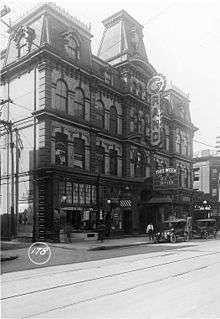Ambrose Small
Ambrose Joseph Small (January 11, 1863 in Bradford, Ontario – vanished December 2, 1919) was a Canadian theatre magnate, who owned theatres in several Ontario cities including the Grand Opera House in Toronto, the Grand Opera House in Kingston, and the Grand Theatre in London, Ontario.
On 2 December 1919, Small disappeared and his body was never recovered. He was 56 years old. It was alleged at the time that Small's wife and her lover killed Small and cremated his body in the London Ontario Grand Opera theater furnace (one of Small's holdings). It was further alleged that a police inspector was involved in a "cover-up" of Small's disappearance.
Disappearance

On December 1, 1919, Ambrose Small sold all his theatrical holdings, at a profit of $1.7 million CAD. On December 2, Small met with lawyer F. W. M. Flock in Small's office at the Grand Opera House. Flock left at 5:30 p.m. and was the last person to see Small alive.
That night, Small disappeared from his office. No one who testified for the police claims to have seen him leave his office, or in the Adelaide and Yonge Street area, outside the building. A newsstand operator, Ralph Savein claimed to have seen Small buying a paper at his stand; however, this claim was later repudiated by the police, who considered it to be an attempt by Savein to gain fame from the case.
Small had no motive to disappear: the millionaire did not take money with him, nor was there any ransom note, let alone evidence of kidnapping. At 56, Small owned theatres in seven Ontario cities and was the controller of 62 other buildings, a self-made millionaire at the height of his career.
The investigation
Original leads
The police launched an extensive investigation in the disappearance of Ambrose Small. The case remained unsolved, until being officially closed in 1960.
The week of his disappearance, Small's Opera House was playing Revelations of a Wife, a show that reportedly attracted full houses. Police analyzed the plot and its themes, but found no leads; Small had not chosen this play to provide cryptic hints.
Theresa Small, his wife, suggested that Small had fallen into the hands of a "designing woman"; police found no candidates.
Along with his office, "Amby" had a "private secret room", with its own entrance. The room is said to have been for assignations and the settling of gambling debts. The room was scoured for leads, albeit unsuccessfully.
Sir Arthur Conan Doyle
Toronto reporters contacted Sir Arthur Conan Doyle about the case, when the author was on a New York visit. Doyle showed interest in the case, bringing the headline "World's Greatest Detective to Solve Small Case". In the end, Doyle decided not to pursue the case.
Charles Fort
American writer and researcher into anomalous phenomena Charles Fort wrote about the unexplained disappearances of Ambrose Small and Ambrose Bierce, and asked "Was somebody collecting Ambroses?" [1]
In popular culture
Small appears as a major character in the Michael Ondaatje novel In the Skin of a Lion. The events concerning him in the novel after his disappearance are fictitious.